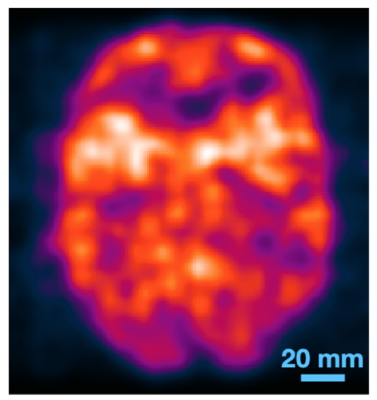
New ultrafast photon detectors allow for rapid processing of data from positron emission or X-ray scans without the need for tomography to reconstruct images. This image shows a brain phantom (model) scanned by positron emission using the new technology. Image courtesy of Simon Cherry, UC Davis
November 1, 2021 — Researchers in the U.S. and Japan have demonstrated the first experimental cross-sectional medical image that doesn’t require tomography, a mathematical process used to reconstruct images in computed tomography (CT) and positron emission tomography (PET) scans. The work, published Oct. 14 in Nature Photonics, could lead to cheaper, easier and more accurate medical imaging.
The advance was made possible by development of new, ultrafast photon detectors, said Simon Cherry, professor of biomedical engineering and of radiology at the University of California, Davis and senior author on the paper.
“We’re literally imaging at the speed of light, which is something of a holy grail in our field,” Cherry said.
Experimental work was led by Sun Il Kwon, project scientist in the UC Davis Department of Biomedical Engineering and Ryosuke Ota at Hamamatsu Photonics, Japan, where the new photon detector technology was developed. Other collaborators included research groups led by Professor Yoichi Tamagawa at the University of Fukui, and by Professor Tomoyuki Hasegawa at Kitasato University.
The process of tomography is required to mathematically reconstruct cross-sectional images from the data in imaging that uses X-rays or gamma rays. In PET scans, molecules tagged with trace amounts of a radioactive isotope are injected and taken up by organs and tissues in the body. The isotope, such as fluorine-18, is unstable and emits positrons as it decays.
Ultrafast Photon Detection
Whenever one of these positrons encounters an electron in the body, they annihilate each other and simultaneously give off two annihilation photons. Tracking the origin and trajectory of these photons theoretically creates an image of the tissues tagged with isotopes. But until now, researchers were unable to do that without the extra step of tomographic reconstruction, because detectors were too slow to precisely determine the arrival times of two photons and thus pinpoint their location based on their time difference.
When the annihilation photons strike the detector, they generate Cherenkov photons that produce the signal. Cherry and his fellow researchers figured out how to detect these Cherenkov photonså with an average timing precision of 32 picoseconds. This meant they could determine where the annihilation photons arose with a spatial precision of 4.8 millimeters. This level of speed and accuracy enabled the research team to produce cross-sectional images of a radioactive isotope directly from the annihilation photons without having to use tomography.
In their paper, the researchers describe various tests they conducted with their new technique, including on a test object that mimics the human brain. They feel confident that this procedure is ultimately scalable to the level needed for clinical diagnostics and has the potential to create higher quality images using a lower radiation dose. Images can also be created more quickly with this method, potentially even in real time during the PET scan, as no after-the-fact reconstruction is needed.
PET scans are currently expensive and are technically limited in some ways, as the full information present in the travel time of the annihilation photons is not captured by current clinical scanners. This new discovery involves a compact equipment setup and could lead to inexpensive, easy and accurate scans of the human body using radioactive isotopes.
For more information: www.ucdavis.edu/


 December 03, 2025
December 03, 2025 









